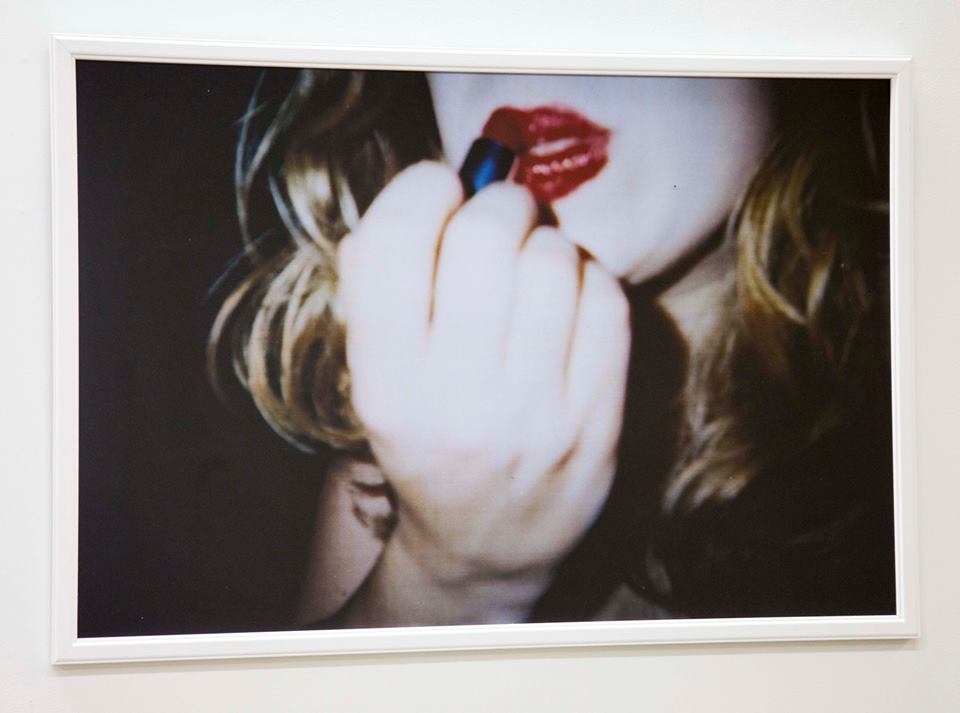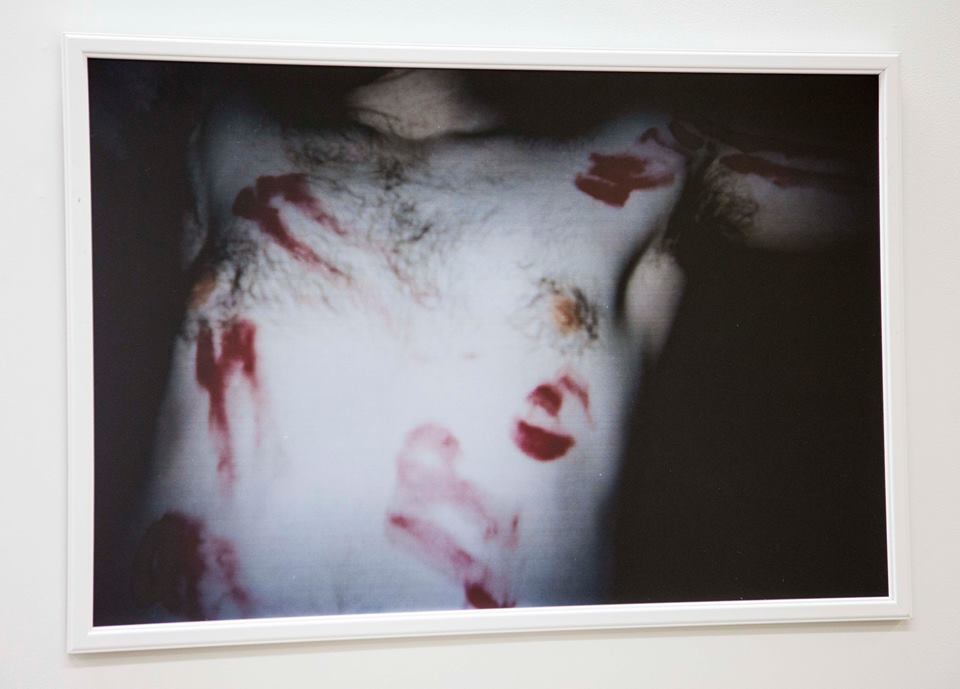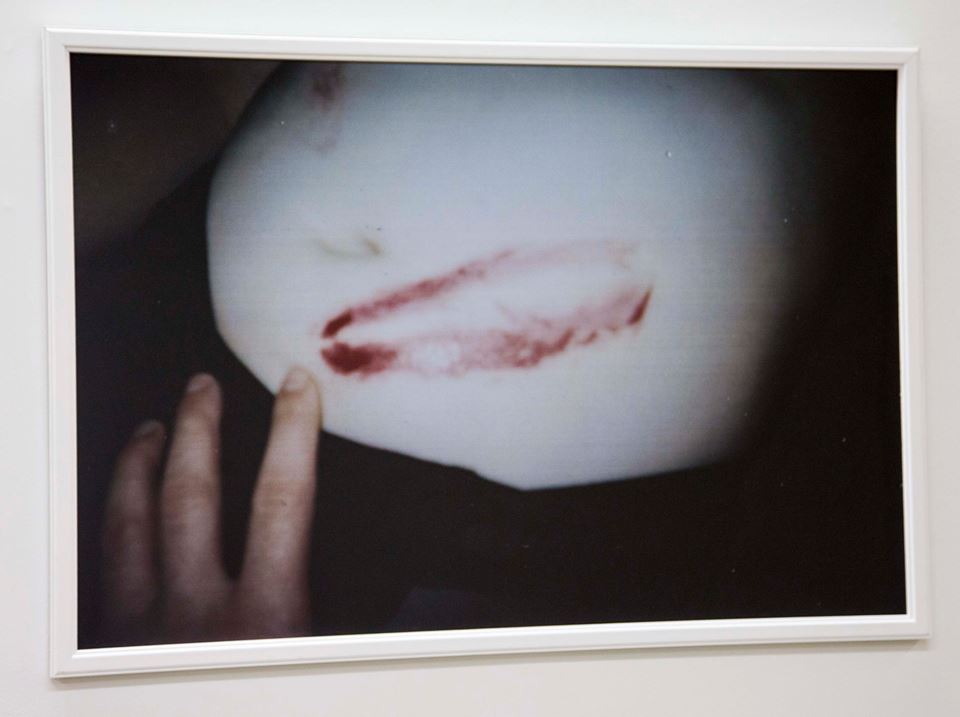
The Lip Sync series uses the act of lip syncing as a tool for exploring personal traumas and things left unspoken, making the invisible visible.
-
“Lip Sync IV” is a performance created for the camera. It involves both myself and my ex boyfriend applying lipstick and then using our mouths to write secrets on each other’s bodies. The work was created as a means to examine the idea of intimacy in a romantic relationship, and ultimately brought unsettling feelings to the surface.

The Lip Sync series uses the act of lip syncing as a tool for exploring personal traumas and things left unspoken, making the invisible visible.
-
“Lip Sync IV” is a performance created for the camera. It involves both myself and my ex boyfriend applying lipstick and then using our mouths to write secrets on each other’s bodies. The work was created as a means to examine the idea of intimacy in a romantic relationship, and ultimately brought unsettling feelings to the surface.

The Lip Sync series uses the act of lip syncing as a tool for exploring personal traumas and things left unspoken, making the invisible visible.
-
“Lip Sync IV” is a performance created for the camera. It involves both myself and my ex boyfriend applying lipstick and then using our mouths to write secrets on each other’s bodies. The work was created as a means to examine the idea of intimacy in a romantic relationship, and ultimately brought unsettling feelings to the surface.

Poem: "Daddy" by Sylvia Plath
In "Lip Sync V (Daddy)," I use my lips as a tool for mark-making in a futile attempt to communicate the immense pain that the suicide of my father has caused me. Although my lips are moving, it is difficult to make out what is being said, and eventually the marks left by the lipstick almost completely obscure my face.

The Lip Sync series uses the act of lip syncing as a tool for exploring personal traumas and things left unspoken, making the invisible visible.
-
Lip Sync VI is a site-specific performance that uses the performers mouth as a mark-making tool in order to speak obliquely about both seen and unseen campus rape and sexual assault. The piece includes both the act of reclamation and the artifact of that act. The performer will walk down Langdon and State Streets, located in Madison, WI, listening to a playlist of songs of her own creation that reference assault. As she listens, she reacts to the music by applying red lipstick and then pressing her mouth up against an exterior surface, lip syncing parts of the songs across buildings and storefront windows. The intimacy of what appears to be a kiss is given new meaning when the performer begins to drag her lips across the building’s exterior. The performance continues until the playlist has cycled through once.
The work is inspired by the image left by the body in Body Tracks by Ana Mendieta, as well as more directly political pieces like Three Weeks in May by Suzanne Lacy, or Rape Scene, also by Ana Mendieta. Similar to Body Tracks, the act elicits an immediate and emotional response in the viewer. The content of the piece references feminist works like Three Weeks in May or Rape Scene, but being wordless, mimics the silence a victim can feel in confronting their individual experiece. The artifact that remains after the action continues to exist as a reminder of the countless acts of violence committed against women in the Madison area.

The work as installation appropriates Ana Mendieta’s gesture in “Body Tracks” using lipstick rubbed on my hands. The violence of Mendieta’s gesture can be read through her forced relocation as a child and with the knowledge that another work, “Rape Scene,” was created around the same time. I appropriate the violence of that gesture in an attempt to make visible the effect my father’s suicide has had on my life. For the performance, I remove my father’s shirt from the wall and spread it on the floor before the audience. Applying the lipstick that was displayed beneath my father’s shirt, I use my mouth to transfer the words from the poem I had written about his death onto the shirt in front of me. Once the entire poem has been transferred to the shirt, I nail the shirt to the wall between the handprints.






The Lip Sync series uses the act of lip syncing as a tool for exploring personal traumas and things left unspoken, making the invisible visible.
-
“Lip Sync IV” is a performance created for the camera. It involves both myself and my ex boyfriend applying lipstick and then using our mouths to write secrets on each other’s bodies. The work was created as a means to examine the idea of intimacy in a romantic relationship, and ultimately brought unsettling feelings to the surface.
The Lip Sync series uses the act of lip syncing as a tool for exploring personal traumas and things left unspoken, making the invisible visible.
-
“Lip Sync IV” is a performance created for the camera. It involves both myself and my ex boyfriend applying lipstick and then using our mouths to write secrets on each other’s bodies. The work was created as a means to examine the idea of intimacy in a romantic relationship, and ultimately brought unsettling feelings to the surface.
The Lip Sync series uses the act of lip syncing as a tool for exploring personal traumas and things left unspoken, making the invisible visible.
-
“Lip Sync IV” is a performance created for the camera. It involves both myself and my ex boyfriend applying lipstick and then using our mouths to write secrets on each other’s bodies. The work was created as a means to examine the idea of intimacy in a romantic relationship, and ultimately brought unsettling feelings to the surface.
Poem: "Daddy" by Sylvia Plath
In "Lip Sync V (Daddy)," I use my lips as a tool for mark-making in a futile attempt to communicate the immense pain that the suicide of my father has caused me. Although my lips are moving, it is difficult to make out what is being said, and eventually the marks left by the lipstick almost completely obscure my face.
The Lip Sync series uses the act of lip syncing as a tool for exploring personal traumas and things left unspoken, making the invisible visible.
-
Lip Sync VI is a site-specific performance that uses the performers mouth as a mark-making tool in order to speak obliquely about both seen and unseen campus rape and sexual assault. The piece includes both the act of reclamation and the artifact of that act. The performer will walk down Langdon and State Streets, located in Madison, WI, listening to a playlist of songs of her own creation that reference assault. As she listens, she reacts to the music by applying red lipstick and then pressing her mouth up against an exterior surface, lip syncing parts of the songs across buildings and storefront windows. The intimacy of what appears to be a kiss is given new meaning when the performer begins to drag her lips across the building’s exterior. The performance continues until the playlist has cycled through once.
The work is inspired by the image left by the body in Body Tracks by Ana Mendieta, as well as more directly political pieces like Three Weeks in May by Suzanne Lacy, or Rape Scene, also by Ana Mendieta. Similar to Body Tracks, the act elicits an immediate and emotional response in the viewer. The content of the piece references feminist works like Three Weeks in May or Rape Scene, but being wordless, mimics the silence a victim can feel in confronting their individual experiece. The artifact that remains after the action continues to exist as a reminder of the countless acts of violence committed against women in the Madison area.
The work as installation appropriates Ana Mendieta’s gesture in “Body Tracks” using lipstick rubbed on my hands. The violence of Mendieta’s gesture can be read through her forced relocation as a child and with the knowledge that another work, “Rape Scene,” was created around the same time. I appropriate the violence of that gesture in an attempt to make visible the effect my father’s suicide has had on my life. For the performance, I remove my father’s shirt from the wall and spread it on the floor before the audience. Applying the lipstick that was displayed beneath my father’s shirt, I use my mouth to transfer the words from the poem I had written about his death onto the shirt in front of me. Once the entire poem has been transferred to the shirt, I nail the shirt to the wall between the handprints.